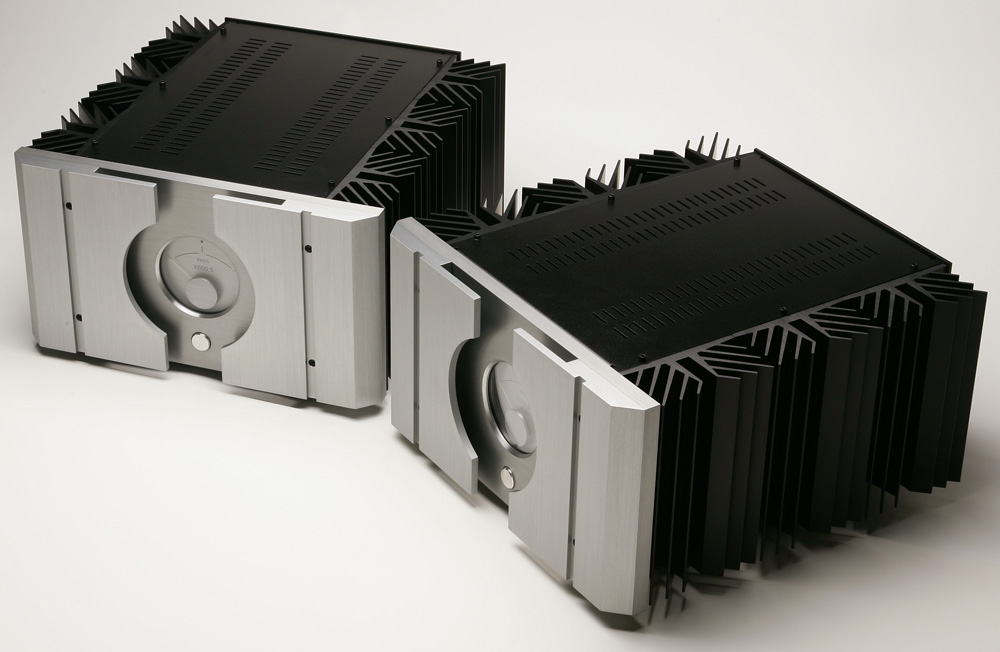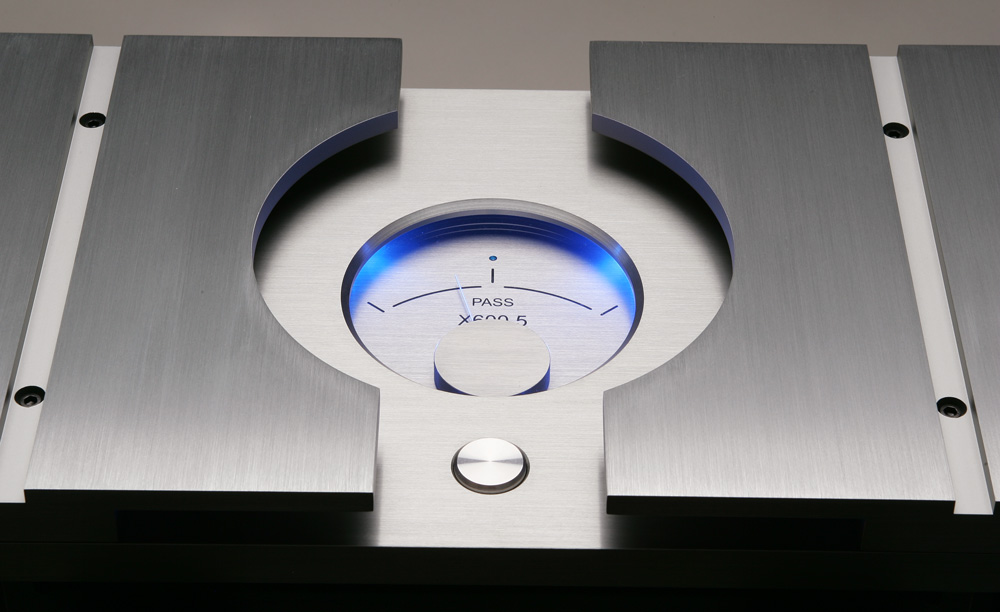When I first approached Pass Labs to conduct a review of the XA160.5 class A monoblock amplifiers I learned that Pass Laboratories, by virtue of influence from Nelson Pass, was a fun-loving, relaxed company to work with. Consider that Nelson was building a wild amplifier at the time entitled, “The Beast with a Thousand JFET’s”. Against that backdrop of casual business atmosphere I met with quite serious components, ones made with slavish attention to detail and particular adroitness in design and build quality. The Pass Labs XP-20 Preamplifier and X600.5 Monoblock Amplifier are examples of the win/win situation created for both the company and the audiophile when refined designs are implemented with outstanding parts. For such reasons, Pass Labs has won a reputation in the audiophile community as gear for serious-minded listeners who do not want to work through permutations of gear in order to set up a fine-sound system.
Nelson does not handle all design at Pass Labs these days, but instead tapped the expertise of engineer Wayne Coburn to handle the design of the XP-Series of preamplifiers. Keeping with the traditional sound of Pass Labs equipment, Wayne and Nelson have made a preamp and amp with an open and airy sound – just what the doctor ordered!
The diseased, or there’s no cure for Ebola
Audiophiles are a sick lot, a bunch of audio-condriacs who sniff at audio systems and scratch their insecurities by collecting “tweaks.” Moping about in a seasonal affective disordered state of the blues, they tumble through ad-hoc systems in search for a cure for disenchantment. While this does not circumscribe the entire demographic of audiophiles, it does encompass a large percentage of them. They return to forums and dealers in droves, seeking a panacea for what ails them – the inability to find contentment with the system they currently own.
I noticed that recently in Guinea a new outbreak of Ebola has surfaced. This is not good, as gruesomely detailed in Richard Preston’s book The Hot Zone. With a kill rate of 90%, this virus is one of the most feared pathogens on the planet. There is no cure for it; the hope is only to contain the hosts, let them die and prevent its propagation. There is, however, a cure for Audiophilia Nervosa and Upgradeitis; the afflicted need to avail them of the proper gear to suit their needs, such as the Pass Labs XP-20 and X600.5, as they may stop the upgrade impulse cold.
Hospital grade
One does not have to be in the audiophile community long before they encounter the phrase, “hospital grade,” particularly in reference to power cords. The designation is supposed to evoke a high standard of construction and supposedly pristine sound quality. If I were to ascribe a general sensation about seeing and using the XP-20 I could do much worse than to call it a hospital grade component. The brushed aluminum casing and washed-out blue LED digits with dual displays for left and right channels evokes images of biological monitors. These are not cuddly kits, but rather cool in a clinical fashion, and they would not appear too out of place next to a centrifuge in a lab.
Pass Labs has been making the X series of preamplifiers since 1998, so a lot of the kinks have been worked out. The XP-20 avoids the absurdity of rows of buttons on the face of the unit, and settles on simple functionality with MUTE, MODE, and INPUT (Left and Right indicated by horizontal arrows) to the left side and a chassis-wide volume dial on the right. A separate, matching power supply unit can be placed either underneath or beside the line stage unit, but don’t try it with the monoblock amps!
The Pass Labs XP-20’s MUTE button removes the signal from the output of the preamp. The MODE button removes the display from the preamp in three increments, “Bright,” “Dim” and “Off.” The default setting, which resets every time the preamp’s power supply is plugged in, is “Bright.” In the “Off” setting the display illuminates as control selections are made for six seconds, then returns to a blank screen. The INPUT select switches toggle through Inputs 1-5.
Input 5 is linked with the PASS THRU (Home Theater) function. It is critical that the gain be reduced to a minimum when first setting the controls for use of the PASS THRU function. Whenever the “Pass Thru” button on the remote is pushed the volume ramps up to 75 in order to prevent serious level mismatches. See the Owner’s Manual for further details.
Savor the medical device-like complexity of the micro-controller, which, “… allows all of the preamplifier functions to be repeatable and accurately controlled.” The digital controls signals are isolated from the signal path and the digital circuits have their own separate power supply from the analogue supply. If the software controlling the preamp ever needs updating, only a socketed microprocessor needs to be changed – safe and secure!
On the Pass Labs XP-20, five inputs are provided, two of which are balanced/XLR and three single ended/RCA. A tape loop with single ended inputs and outputs is provided. The XP-20 has three pair of outputs, all having identical gain structure, one pair balanced and two pair single ended. Though the single ended outputs are paralleled they have low output impedance and high current capability, so more than one output can be used at a time, i.e. one set to the amp for the main speakers and another to powered subwoofers. More durable than a heart replacement valve, the Owner’s Manual states, “The input and output connectors were carefully selected to withstand a lifetime of frequent use.” It’s good to know that the connections on the preamp will still be snug long after the owner’s heart stops pumping!
A couple warnings to ensure healthy use of the Pass Labs XP-20 are in order; the DIN-25 umbilical cable between the power supply and the line stage should never be connected or removed when the power supply unit is plugged into the wall outlet. The power supply has no ON/OFF switch, but rather is powered up when plugged in. Another perhaps overly cautious check is in order upon receiving the preamplifier, that being verification of the unit’s voltage and current rating for local power conditions. A tag on the rear of the unit indicates 240 volts, 220 volts, 120 volts or 100 volts. I have once or twice received a component intended for overseas use having the wrong power supply for the local utility voltage.
Particulars of the X600.5
The Pass Labs X600.5 monoblock amplifier is bold and unencumbered both in aspect and operation. The chunky brushed aluminum façade of the amp matches the front of the XP-20 preamplifier and frames the ubiquitous blue Pass Labs meter as if it were an electronic crèche. The obligatory hospital-sized power button is just below.
The meters always draw attention and are often not understood properly, so I repeat here what I was told about them from my article about the XA160.5: “The meters on our amplifiers are different. They reflect the current consumption of the amplifier, and when the amplifier is operating, they don’t go down to zero like the meters on other amplifiers. This is because the electrical current consumption of our circuits has a fairly high value at all times, a property called the bias. The bias current runs through the amplifiers at a minimum value, determining the class of operation – Class B, Class AB, or Class A.”
Audiophiles can be horridly anal about things like meters, and I’m sure the discovery of the needle on the amp hovering to the side of dead center would be a cause for alarm to some. All it takes to quell fears that the Pass Labs X600.5 is not in operational disease is to scan the images on the Internet, where the needle of the functioning amp is seen most often not centered. So, go ahead and lay that irrational demand for a perfectly vertical needle on the Pass Labs meter to rest.
On the backside are found both an XLR and RCA input, two pairs of output connectors (they accept only spade terminations), a pair of binding post connectors for remote power on, a thermal magnetic breaker switch and a detachable IEC 15A power cord socket.
Built with “Supersymmetry” topology, the X600.5 is said to have, “… a connection between the two halves of the balanced circuit that further perfects the match of common mode artifacts.” A balanced power circuitry scheme might typically achieve a 90% reduction in distortion and noise, but Supersymmetry offers an additional 90% reduction, “… such that it has about 1/100th of the distortion of a conventionally simple and otherwise identical amplifier.” I take the primary benefit of that extreme design and build quality to be heard in the preternaturally expanded soundstage with a high degree of subtlety as regards the performers and instruments, as will be discussed further.
Regarding warm-up and listening quality
With all this technical prowess Pass Labs opts to keep a lighter tone in its Owner’s Manual. Consider the levity of the comments introducing the topic of component warm up:
“There is an Extremely Small (but Non-zero) Chance That, Through a Process Known as Tunneling, This Product May Spontaneously Disappear from Its Present Location and Reappear at Any Random Place within the Universe, Including Your Neighbor’s Domicile. The Manufacturer Will Not Be Responsible for Any Damages, Inconvenience or Mental Anguish That May Result.
There is a much higher probability that when you first plug your new pre-amps power supply into the wall and listen to your favorite selections that you will not be experiencing the full measure of performance this product is capable of. These are high bias Class A topology circuits and their performance is largely temperature dependent.”
Notice how nothing is said about the impact of warm up upon the condition of Tunneling. This is a serious oversight on part of Pass Labs, and I suggest they conduct research to resolve that question, for surely a few hyper-intuitive listeners will want to know whether a Tunneled amp needs as much warm up!
- (Page 1 of 2)
- Next page →


Superb honest review. Doug Schroeder tells you something that I concur with about the character of these beautiful audio pieces. Not your standard review (like in the last 25 years) that everthing is great and the successors are even greater, but he tells you honestly what’s on his mind.
Much kudos for you Doug